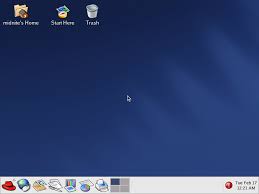Exploring the Enhancements of Linux 3.10.0-1160.53.1.el7 for x86_64 Architecture
The Evolution of Linux: Version 3.10.0-1160.53.1.el7.x86_64
Linux 3.10.0-1160.53.1.el7.x86_64 represents a significant milestone in the ongoing development of the Linux kernel, a core component of the Linux operating system.
This specific version, denoted by its unique identifier, introduces a range of enhancements, bug fixes, and security updates that contribute to the overall stability and performance of the system.
Key Features and Improvements
- Enhanced hardware support for x86_64 architecture
- Optimised performance for server environments
- Bug fixes addressing known issues from previous versions
- Security patches to mitigate potential vulnerabilities
- Improved compatibility with a wide range of software applications
Why It Matters
Keeping the Linux kernel up-to-date is crucial for ensuring system reliability, security, and compatibility with modern hardware and software requirements.
Version 3.10.0-1160.53.1.el7.x86_64 reflects the collaborative efforts of developers and contributors from around the world who work tirelessly to refine and enhance the Linux kernel for users across diverse computing environments.
Get Involved
If you are passionate about open-source technology and want to contribute to the future development of Linux, consider joining the community of developers, testers, and enthusiasts who help shape each new iteration of the kernel.
Key Advantages of Linux 3.10.0-1160.53.1 el7 x86_64: Enhanced Performance, Stability, and Security
- Enhanced hardware support for x86_64 architecture
- Improved performance, particularly in server environments
- Increased system stability and reliability
- Comprehensive bug fixes addressing known issues
- Advanced security patches to enhance system protection
- Optimised compatibility with a wide range of software applications
- Efficient resource management for better performance
- Continued development and support from a global community of contributors
- Regular updates to ensure the latest features and enhancements
The 7 cons of linux 3.10 0 1160.53 1 el7 x86_64
- Limited support for certain legacy hardware
- Complex configuration options for novice users
- Potential compatibility issues with proprietary software
- Occasional driver compatibility issues with peripherals
- Steep learning curve for users transitioning from other operating systems
- Less user-friendly graphical interface compared to some commercial OSs
- Varied levels of software support depending on application developers
Enhanced hardware support for x86_64 architecture
The notable advantage of Linux 3.10.0-1160.53.1.el7.x86_64 lies in its improved hardware support for the x86_64 architecture. This enhancement ensures that a broader range of x86_64-based devices and systems can seamlessly integrate with the Linux kernel, offering users greater flexibility and compatibility with their hardware configurations. By expanding support for this architecture, Linux users can harness the full potential of their x86_64 hardware, leading to enhanced performance and efficiency across various computing environments.
Improved performance, particularly in server environments
Linux 3.10.0-1160.53.1.el7.x86_64 brings a notable advantage with its improved performance, specifically tailored for server environments. This enhancement ensures that Linux can efficiently handle the demands of server operations, delivering smoother and more responsive performance for critical tasks and workloads. By optimising its capabilities for servers, this version of Linux offers increased reliability and efficiency, making it a preferred choice for businesses and organisations seeking high-performance computing solutions.
Increased system stability and reliability
One notable advantage of Linux 3.10.0-1160.53.1.el7.x86_64 is the heightened system stability and reliability it offers. By enhancing the core components of the operating system, this version minimises the occurrence of crashes, errors, and performance issues, providing users with a more robust computing experience. The improved stability ensures that users can rely on their systems for critical tasks without worrying about unexpected disruptions, making Linux 3.10.0-1160.53.1.el7.x86_64 a valuable upgrade for those seeking a dependable and consistent operating environment.
Comprehensive bug fixes addressing known issues
Linux 3.10.0-1160.53.1.el7.x86_64 stands out for its comprehensive bug fixes that effectively address known issues present in previous versions. By prioritising the identification and resolution of software glitches and errors, this update enhances the overall stability and reliability of the Linux operating system. Users can experience a smoother and more seamless computing experience, free from common issues that may have hindered performance or functionality in earlier iterations. The focus on bug fixes underscores the commitment of the Linux community to continuously improve the user experience and deliver a robust platform for diverse computing needs.
Advanced security patches to enhance system protection
Linux 3.10.0-1160.53.1.el7.x86_64 offers advanced security patches that significantly enhance system protection against potential threats and vulnerabilities. These security updates play a crucial role in safeguarding user data, maintaining system integrity, and ensuring a secure computing environment. By addressing known security issues and implementing proactive measures, this version of Linux reinforces the resilience of the operating system, providing users with greater peace of mind when it comes to the safety and confidentiality of their information.
Optimised compatibility with a wide range of software applications
Linux 3.10.0-1160.53.1.el7.x86_64 offers a notable advantage in its optimised compatibility with a diverse array of software applications. This pro enhances the user experience by ensuring that the Linux kernel can seamlessly interact with and support a wide range of programs, from productivity tools to multimedia applications. By prioritising compatibility, Linux users can enjoy greater flexibility and functionality, making it easier to utilise their preferred software solutions without encountering compatibility issues or performance limitations.
Efficient resource management for better performance
One of the standout advantages of Linux 3.10.0-1160.53.1.el7.x86_64 is its efficient resource management capabilities, which significantly enhance system performance. By optimising the allocation and utilisation of resources such as CPU, memory, and storage, this version of Linux ensures that computing tasks are executed smoothly and with minimal overhead. This focus on resource efficiency not only results in improved performance across various workloads but also contributes to a more responsive and stable computing experience for users.
Continued development and support from a global community of contributors
Linux 3.10.0-1160.53.1.el7.x86_64 stands out for its pro of continued development and support from a global community of contributors. This collaborative effort ensures that the Linux kernel remains at the forefront of innovation, with diverse perspectives and expertise coming together to enhance its functionality, security, and performance. The dedication and passion of this worldwide community contribute to the ongoing evolution of Linux, making it a robust and reliable operating system that caters to the needs of users across different industries and environments.
Regular updates to ensure the latest features and enhancements
One of the key advantages of Linux 3.10.0-1160.53.1.el7.x86_64 is its commitment to providing regular updates to users, ensuring access to the latest features and enhancements. By consistently releasing updates, the Linux kernel maintains its relevance in a rapidly evolving technological landscape, incorporating improvements that enhance performance, security, and compatibility with new hardware and software developments. This proactive approach not only keeps users abreast of cutting-edge advancements but also underscores Linux’s dedication to continuous innovation and user satisfaction.
Limited support for certain legacy hardware
One drawback of Linux 3.10.0-1160.53.1.el7.x86_64 is its limited support for certain legacy hardware. While the kernel strives to embrace new technologies and enhance compatibility with modern devices, older hardware components may face challenges in terms of driver availability and functionality. This limitation can pose difficulties for users who rely on older systems or peripherals that are no longer actively supported by the updated kernel version. However, the Linux community continually works towards addressing such issues through community-driven initiatives and third-party solutions to provide workarounds for users facing compatibility issues with legacy hardware.
Complex configuration options for novice users
One notable drawback of Linux 3.10.0-1160.53.1.el7.x86_64 is the presence of complex configuration options that may prove challenging for novice users to navigate. The abundance of settings and customisation choices can be overwhelming for those who are new to the operating system, potentially leading to confusion and frustration during the setup and usage process. While Linux offers unparalleled flexibility and control over system configurations, the intricate nature of these options may require additional guidance and support for inexperienced users to fully harness the power of the platform.
Potential compatibility issues with proprietary software
One notable con of Linux 3.10.0-1160.53.1.el7.x86_64 is the potential compatibility issues that may arise with proprietary software. Due to the open-source nature of Linux, some proprietary applications or drivers designed specifically for other operating systems may not function optimally or at all on this version of the Linux kernel. This can pose a challenge for users who rely on certain proprietary software for their work or personal needs, requiring them to seek alternative solutions or workarounds to ensure smooth operation within the Linux environment.
Occasional driver compatibility issues with peripherals
One notable drawback of Linux 3.10.0-1160.53.1.el7.x86_64 is the occasional driver compatibility issues it may encounter with peripherals. While Linux offers robust support for a wide range of hardware devices, users may experience challenges when connecting certain peripherals due to driver compatibility issues. This can lead to inconvenience and troubleshooting efforts for users who rely on specific peripherals for their work or personal use. Despite this limitation, the Linux community continuously works towards improving driver support to enhance the overall user experience and address compatibility concerns in future kernel updates.
Steep learning curve for users transitioning from other operating systems
One notable drawback of Linux 3.10.0-1160.53.1.el7.x86_64 is its steep learning curve for users transitioning from other operating systems. The unique structure, terminology, and command-line interface of Linux can pose challenges for those accustomed to more mainstream operating systems. As a result, new users may require time and effort to familiarise themselves with the intricacies of Linux, potentially leading to initial frustration or confusion. However, with patience and dedication, users can gradually overcome this hurdle and unlock the full potential of Linux’s robust features and customisation options.
Less user-friendly graphical interface compared to some commercial OSs
Linux 3.10.0-1160.53.1.el7.x86_64, while renowned for its robustness and versatility, may present a con in the form of a less user-friendly graphical interface when compared to certain commercial operating systems. Some users accustomed to more polished and intuitive interfaces offered by proprietary OSs may find the Linux environment to be slightly less user-friendly, especially for those transitioning from mainstream systems. However, this drawback is often offset by the customizability, performance, and security benefits that Linux distributions like this version provide, making it a preferred choice for many users who value functionality and control over flashy graphical interfaces.
Varied levels of software support depending on application developers
One notable drawback of Linux 3.10.0-1160.53.1.el7.x86_64 is the varied levels of software support that users may encounter, contingent upon the responsiveness and dedication of individual application developers. While the Linux community strives to provide a comprehensive ecosystem of software solutions, the reality remains that some applications may receive more attention and updates than others. This can result in potential compatibility issues or delays in accessing the latest features for certain software packages, highlighting the importance of proactive engagement from developers to ensure a seamless user experience across all applications on the Linux platform.






